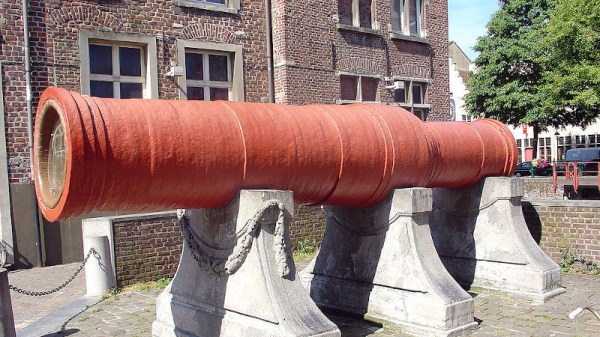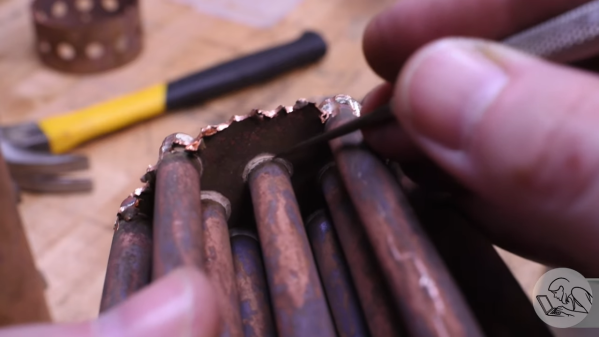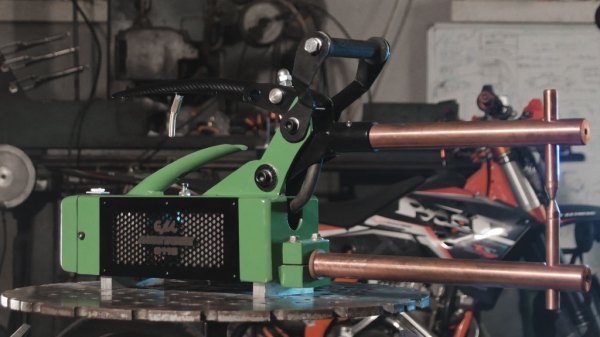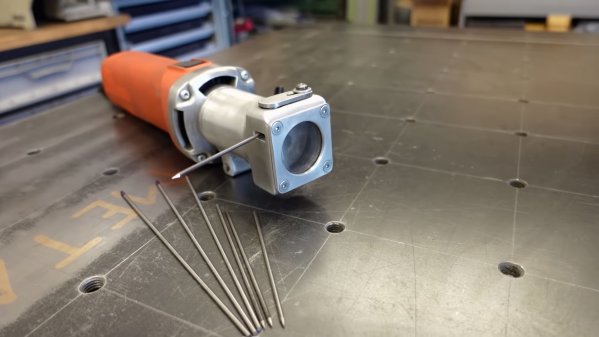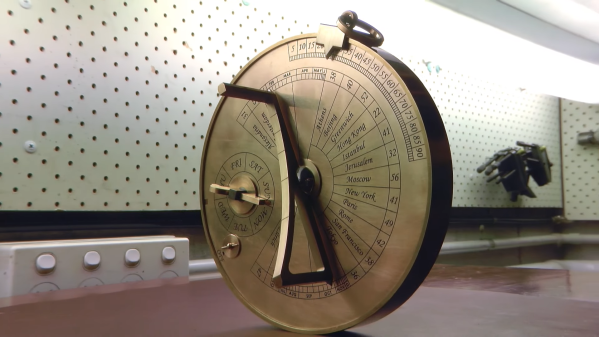For a happy weekend away in early September, I joined a few of my continental friends for the NewLine event organised by Hackerspace Gent in Belgium. You may have seen some of the resulting write-ups here, and for me the trip is as memorable for the relaxing weekend break it gave me in a mediaeval city as it is for the content of the talks and demonstrations. We took full advantage of the warm weather to have some meals out on café terraces, and it was on the way to one of them that my interest was captured by something unexpected. There at the end of the street was a cannon, not the normal-size cannon you’ll see tastefully arranged around historical military sites the world over, but a truly massive weapon. I had stumbled upon Dulle Griet, one of very few surviving super-sized 15th century siege cannons. It even had a familiar feel to it, being a sister to the very similar Mons Meg at Edinburgh Castle in Scotland.
metalwork55 Articles
Hackaday Links: September 19, 2021
Things might be getting a bit dicey out in Jezero crater for Ingenuity. The little helicopter that could is starting to have trouble dealing with the thinning Martian atmosphere, and may start pressing against its margin of safety for continued operation. Ingenuity was designed for five flights that would all take place around the time its mothership Perseverance touched down on Mars back in February, at which time the mean atmospheric pressure was at a seasonal high. Over the last few months, the density of the Martian atmosphere has decreased a wee bit, but when you’re starting with a plan for a pressure that’s only 1.4% of Earth’s soupy atmosphere, every little bit counts. The solution to keeping Ingenuity flying is simple: run the rotors faster. NASA has run a test on that, spinning the rotors up to 2,800 RPM, and Ingenuity handled the extra stresses and power draw well. A 14th flight is planned to see how well the rotors bite into the rarefied air, but Ingenuity’s days as a scout for Perseverance could be numbered.
If you thought privacy concerns and government backdoors into encryption technology were 21st-century problems, think again. IEEE Spectrum has a story about “The Scandalous History of the Last Rotor Cipher Machine,” and it’s a great read — almost like a Tom Clancy novel. The story will appeal to crypto — not cryptocurrency — fans, especially those fascinated by Enigma machines, because it revolves around a Swiss rotor cipher machine called the HX-63, which was essentially a refinement of the original Enigma technology. With the equivalent of 2,000-bit encryption, it was considered unbreakable, and it was offered for sale to any and all — at least until the US National Security Agency sprung into action to persuade the inventor, Boris Hagelin, to shelve the HX-63 project in favor of electronic encryption. The NSA naturally helped Hagelin design this next generation of crypto machines, which of course all had backdoors built into them. While the cloak and dagger aspects of the story — including a possible assassination of Boris Hagelin’s son in 1970, when it became clear he wouldn’t “play ball” as his father had — are intriguing, the peek inside the HX-63, with its Swiss engineering, is the real treat.
One of the great things about the internet is how easy it is to quickly answer completely meaningless questions. For me, that usually involves looking up the lyrics of a song I just heard and finding out that, no, Robert Plant didn’t sing “Whoopie Cat” during Misty Mountain Hop. But it also let me answer a simple question the other day: what’s the largest single-piece metal object ever created? I figured it would have to be a casting of some sort, and likely something from the middle of the previous century. But as it turns out, the largest casting ever appears to have been manufactured in Sheffield, England in 2015. The company, Sheffield Forgemaster International, produced eleven castings for the offshore oil industry, each weighing in at over 320 tonnes. The scale of each piece is mind-boggling, and the technology that went into making them would be really interesting to learn about. And it goes without saying that my search was far from exhaustive; if you know of a single-piece metal part larger than 320 tonnes, I’ll be glad to stand corrected.
Have you heard about “teledriving” yet? On the face of it, a remote-controlled car where a qualified driver sits in an office somewhere watching video feeds from the car makes little sense. But as you dig into the details, the idea of remotely piloted cars starts to look like one of those “Why didn’t I think of that?” ideas. The company behind this is called Vay, and the idea is to remotely drive a ride-share vehicle to its next customer. Basically, when you hail a ride, a remote driver connects to an available car and drives it to your location. You get in and take over the controls to drive to your destination. When you arrive, another remote drive pilots the car to its next pickup. There are obvious problems to work out, but the idea is really the tacit admission that all things considered, humans are way better at driving than machines are, at least right now.
Fail Of The Week: Learning How Not To Silver Solder
Sure, there are subtleties, but by and large it’s pretty easy to pick up soldering skills with a little practice. But wait! Not all soldering is created equal, and as [Quinn Dunki] learned, silver soldering is far harder to get right.
Granted, the job [Quinn] is working on is much more demanding than tacking some components to a PCB. She has been building a model steam engine, a task fit to put anyone’s machining skills to the test. And a steam engine needs a boiler, which is where the silver soldering comes in. As she explains in the video below, silver soldering, or “hard” soldering, uses solder that melts at a much higher temperature than “soft” solders like we’re used to in electronics. That’s a big advantage in the heat and pressure of a boiler, but it does pose some problems, many of which [Quinn] managed to discover as she tried to assemble her copper beast.
It turns out that heating a big hunk of copper evenly without burning off the flux actually isn’t that easy, though you can’t say she didn’t give it the old college try. In the process, she managed to share a number of tidbits that were really interesting, like the fact that drawing acetylene from a tank too fast can be dangerous, or that model steam boilers have to be certified by qualified inspectors. In the end, her boiler couldn’t be salvaged, and was put to the saw to determine the problem, which seems to be her initial choice of heating with oxyacetylene; after that initial failure, there was little she could do to save the boiler.
As [Quinn] says, “Failure is only failure if you don’t learn from it.” And so it may be a bit unfair to hang “Fail of the Week” on this one, but still — she has to go back to the beginning on the boiler. And we already know that model steam engines aren’t easy.
Continue reading “Fail Of The Week: Learning How Not To Silver Solder”
Ambitious Spot Welder Really Pushes The Amps
On the face of it, a spot welder is a simple device. If you dump enough current through two pieces of metal very quickly, they’ll heat up enough to melt and fuse together. But as with many things, the devil is in the details, and building a proper spot welder can be as much about addressing those details as seeing to the basics.
We haven’t featured anything from our friends over at [Make It Extreme], where they’re as much about building tools as they are about using them to build other things, if not more so. We expect, though, that this sturdy-looking spot welder will show up in a future video, because it really looks the business, and seems to work really well. The electronics are deceptively simple — just rewound microwave oven transformers and a simple timer switch to control the current pulse. What’s neat is that they used a pair of transformers to boost the current considerably — they reckon the current at 1,000 A, making the machine capable of welding stock up to 4 mm thick.
With the electrical end worked out, the rest of the build concentrated on the housing. A key to good-quality spot welds is solid physical pressure between the electrodes, which is provided by a leverage-compounding linkage as well as the long, solid-copper electrodes. We’ve got to say that the sweep of the locking handle looks very ergonomic, and we like the way closing down the handle activates the current pulse. Extra points for the carbon-fiber look on the finished version. The video below shows the build and a demo of what it can do.
Most of the spot welders we see are further down the food chain than this one, specialized as they are for welding battery packs and the like. We do recall one other very professional-looking spot welder, though.
Continue reading “Ambitious Spot Welder Really Pushes The Amps”
Zinc Fever: A Look At The Risks Of Working With Hot Metal
For as raucous as things can get in the comments section of Hackaday articles, we really love the give and take that happens there. Our readers have an astonishing breadth of backgrounds and experiences, and the fact that everyone so readily shares those experiences and the strongly held opinions that they engender is what makes this community so strong and so useful.
But with so many opinions and experiences being shared, it’s sometimes hard to cut through to the essential truth of an issue. This is particularly true where health and safety are at issue, a topic where it’s easy to get bogged down by an accumulation of anecdotes that mask the underlying biology. Case in point: I recently covered a shop-built tool cabinet build and made an off-hand remark about the inadvisability of welding zinc-plated drawer slides, having heard about the dangers of inhaling zinc fumes once upon a time. That led to a discussion in the comments section on both sides of the issue that left the risks of zinc-fume inhalation somewhat unclear.
To correct this, I decided to take a close look at the risks involved with welding and working zinc. As a welding wannabe, I’m keenly interested in anything that helps me not die in the shop, and as a biology geek, I’m also fascinated by the molecular mechanisms of diseases. I’ll explore both of these topics as we look at the dreaded “zinc fever” and how to avoid it.
Continue reading “Zinc Fever: A Look At The Risks Of Working With Hot Metal”
Put The Perfect Point On Your Tungstens With This Die Grinder Attachment
Aspiring TIG welders very quickly learn the importance of good tungsten electrode grinding skills. All it takes is a moment’s distraction or a tiny tremor in the torch hand to plunge the electrode into the weld pool, causing it to ball up and stop performing its vital function. Add to that the fussy nature of the job — tungstens must only be ground parallel to the long axis, never perpendicular, and at a consistent angle — and electrode maintenance can become a significant barrier to the TIG beginner.
A custom tungsten grinder like this one might be just the thing to flatten that learning curve. It comes to us by way of [The Metalist], who turned an electric die grinder into a pencil sharpener for tungsten electrodes. What we find fascinating about this build is the fabrication methods used, as well as the simplicity of the toolkit needed to accomplish it. The housing of the attachment is built up from scraps of aluminum tubing and sheet stock, welded together and then shaped into a smooth, unibody form that almost looks like a casting. Highlights include the mechanism for adjusting the angle of the grind as well as the clever way to slit the body of the attachment so it can be clamped to the nosepiece of the die grinder. We also thought the inclusion of a filter to capture tungsten dust was a nice touch; most TIG electrodes contain a small amount of lanthanum or thorium, so their slight radioactivity is probably best not inhaled.
We love builds like this that make a tedious but necessary job a little quicker and easier to bear, and anything that stands to make us a better welder — from simple purpose-built fixtures to large-scale rotary tables — is OK in our book.
Continue reading “Put The Perfect Point On Your Tungstens With This Die Grinder Attachment”
For Your Holiday Relaxation: The Clickspring Sundial Build Megacut
The fortunate among us may very well have a bit of time off from work coming up, and while most of that time will likely be filled with family obligations and festivities, there’s probably going to be some downtime. And if you should happen to find yourself with a half hour free, you might want to check out the Clickspring Byzantine Calendar-Sundial mega edit. And we’ll gladly accept your gratitude in advance.
Fans of machining videos will no doubt already be familiar with Clickspring, aka [Chris], the amateur horologist who, through a combination of amazing craftsmanship and top-notch production values, managed to make clockmaking a spectator sport. We first caught the Clickspring bug with his open-frame clock build, which ended up as a legitimate work of art. [Chris] then undertook two builds at once: a reproduction of the famous Antikythera mechanism, and the calendar-sundial seen in the video below.
The cut condenses 1,000 hours of machining, turning, casting, heat-treating, and even hand-engraving of brass and steel into an incredibly relaxing video. There’s no narration, no exposition — nothing but the sounds of metal being shaped into dozens of parts that eventually fit perfectly together into an instrument worthy of a prince of Byzantium. This video really whets our appetite for more Antikythera build details, but we understand that [Chris] has been busy lately, so we’ll be patient.
Continue reading “For Your Holiday Relaxation: The Clickspring Sundial Build Megacut”

